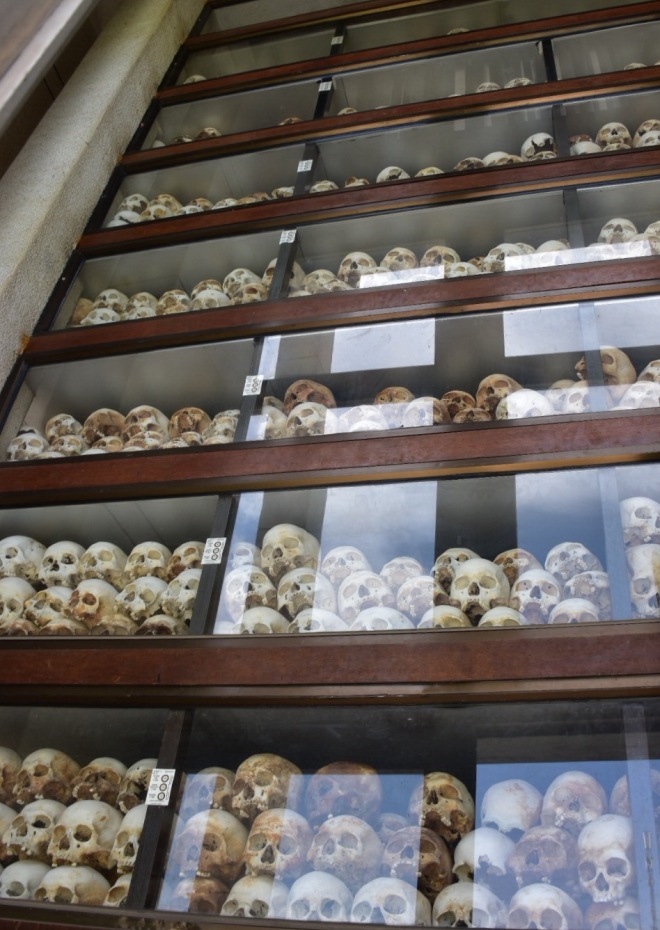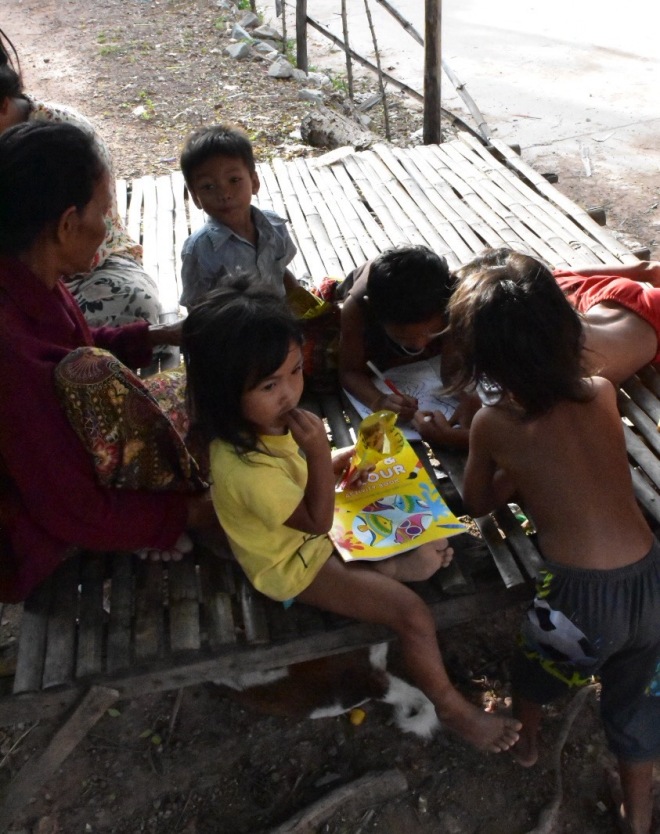
“Three years, eight months and twenty days” this is a timeframe etched on the Khmer people and it’s a phrase often quoted here when referring to the genocidal regime of the Khmer Rouge led by Pol Pot. It coldly quantifies Cambodia’s darkest time, the period when over 2 million Khmer were murdered – a quarter of the country’s population.
In our previous blog we struggled to find the superlatives to justify the astonishing beauty to be found in Cambodia. This week having visited the Killing Fields it’s equally hard, if not harder to find the words to adequately convey the horror inflicted on the innocent victims who are commemorated in Phnom Penh.
We should begin by addressing the question of writing on this subject and sharing photos. We had mixed feelings about what was appropriate and in some locations quite rightly photography isn’t allowed.
However, visitors are thanked, welcomed and movingly told that by paying their respects at the Killing Fields they become holders of the memory of the Khmer Rouge’s genocide; encouraged to share the story of what happened and to remember the victims so that such atrocities can be avoided in the future. So we will share with you our experience.
Memorial at S-21:

The Khmer people had suffered in the years prior to Khmer Rouge – a bloody civil war and the USA bombing campaigns in Kampuchea. Indeed, many initially celebrated the victory of the Khmer Rouge and the end of Civil War, but that was short lived. Within hours of entering Phnom Penh its inhabitants were told to leave for the countryside immediately on the pretence that the US were about to bomb the city. Incredibly the capital city, Phnom Penh, was emptied in 3 days – a ghost town.
So began ‘Year Zero’ and the implementation of ‘Brother 1’ Pol Pot’s regime that sent everyone to farms to create a peasant society. Professional people, the educated, monks, priests were all viewed with suspicion and would perish. Even wearing glasses marked you out as the enemy as this indicated an ability to read – no longer necessary and certainly enough reason to be executed.
There are two key sites in Phnom Penh that commemorate the genocide that took place from April 1975 to January 1979. We first visited Tuol Sleng Prison – simply known as S-21. A converted school, S-21 became the notorious centre of interrogation and torture of anyone suspected of being a traitor to Khmer Rouge, which in an increasingly paranoid regime became just about anyone.

Treatment of prisoners was barbaric with guards instructed not to kill prisoners but to prolong torture ensuring ‘confessions’ were obtained. The confessions typically involved admitting to spying for the enemy and naming fellow ‘conspirators’; which in turn led to more arrests and torture. Such was the madness of the regime that having killed all of the qualified doctors and nurses, Prison Guards had to learn rudimentary medical skills to try to keep prisoners alive to continue their torture. Some prisoners tried to end their misery by committing suicide by jumping off the high balconies at S-21, which led to barbed wire being put up to stop them.

The Prison Guards themselves were often imprisoned if they failed to extract confessions or killed a prisoner before he or she had signed their confession. It was a system built on fear and brutality.
The prison cells are small, basic and bleak. In many of the communal cell areas there are displays showing row upon row of photos of prisoners faces who look scared and bewildered. Like the Nazis, the Khmer Rouge maintained detailed records of their victims much of which they failed to destroy when they eventually fled Phnom Penh.
A very small handful of prisoners survived S-21 & we were privileged to meet two of them on site. They promote the work to remember the genocide and gave evidence in some of the War Crime trials that belatedly took place almost 30 years after the
Khmer Rouge were defeated. Not surprisingly they are haunted by the experience, grieving for the family, friends and fellow Khmer who lost their lives.
Choeung Ek
Following S-21 we made the trip to Choeung Ek, about 10 miles south of the city. There are a number of Killing Fields throughout Cambodia and Choeung Ek is the main memorial site. After obtaining confessions at S-21, prisoners were transported here along with others who had been rounded up – their final journey. In order to save ammunition prisoners were usually beaten to death, had their throats cut and were thrown into mass graves. After the war ended almost 9000 bodies were discovered at the site, although many more have been left undisturbed.
Bones and scraps of clothes regularly rise to the surface of the fields, especially during rainy season, revealing further chilling evidence of the scale of the Killing Field. In fact, we saw a small pile of bones which had been collected and were waiting proper commemoration.

The site includes the Killing Tree, a site of unimaginable terror where shards of bone and flesh were found in its trunk when Choeung Ek was discovered after the defeat of the Khmer Rouge. Next to the tree a mass grave of children and infants was found. The Khmer Rouge’s twisted logic was that they did not want children avenging the death of their murdered parents, so they were bludgeoned to death against the tree, their feet held in the hands of the aggressors, their skulls smashed against the tree and dropped into the grave. It is a terrible shock to learn of these atrocities and then to find the same tree still standing there overhanging the excavated grave. Of all the atrocities we learned of at the Killing Fields, this particular spot was a place which jolted both of us. We had to take time to reflect as we stood besides this tree that had witnessed such unimaginable horrors.
At the centre of the Killing Field is the Choeung Ek Monument, a glass-walled Bhuddist Stupa that contains over 5000 skulls, many displaying their final injury. The monument along with the site in general is overwhelming.

We visited Auschwitz a couple of years ago and walking around Choeung Ek, trying to imagine the fear and desperation of its victims led to very similar feelings – anger and disbelief giving way to a sense of respectful tranquility and sadness at the most appalling injustice meted out to innocent people. It is an incredibly moving and upsetting experience.

Visiting these sites and writing about it is difficult, but we both wanted to better understand what happened, how and why; and most importantly to reflect and pay our respects.
We wish we could finish on a positive note, describing how Cambodia has flourished since ridding itself of the tyranny of Pol Pot – unfortunately we can’t. When we first arrived in Siem Reap the national elections were taking place. However, it became clear quickly that these were not open and fair. The Government and Prime Minister has remained in power since 1979 when Khmer rebels fighting the Khmer Rouge were supported by the Vietnamese to topple Pol Pot. Sadly, it seems the leaders of that revolt have made the familiar journey from freedom fighters to dictators over the course of the following decades. Political opponents are imprisoned or exiled, a free press closed down, and the electorate intimidated into voting (or face reprisals).
It feels as though in trying to recover from and never revisit the fear of the genocide of Khmer Rouge, current generations of Khmer people are being subjugated, unable to create independence from a Government influenced by Vietnam and an economy increasingly controlled by China.
Our time in Cambodia has been a mixed one. The stunning beauty of Angkor Watt and the surrounding temples, contrasting with the legacy of Khmer Rouge. The lovely relaxed feeling of Siem Reap compared with a more seedy and edgy Phnom Penh. Throughout it all have been the wonderful Khmer people who are so warm, friendly and welcoming; deserving so much more than their recent history and current government gives them.

Next Week: A Return to Vietnam to see family & friends.




moving stuff guys (
LikeLiked by 1 person
Thanks Spencer!
LikeLike
Great post, guys. A fair lot of ethical considerations to get over it seems but a good story told well. Oli Poole.
LikeLiked by 1 person
Thanks Oli, much appreciated. Hope you are well.
LikeLike
Cabinets of skulls . . . . . . .
LikeLiked by 1 person
Thank you John & Sam ….. difficult.
Reading you post brought back my visit to Yad Vashem in Jerusalem last year. I did not complete the tour, I had to leave the building feeling claustrophobic and panic. In the fresh air I sat and waited for a colleague to pick me up, when I got in the car I just started crying. It was really too much for me.
I can only imagine your struggle as you looked on at the sights and read the detail…….
LikeLiked by 1 person
Crazy I was there too, on the same day as you!!!
LikeLike
Hi Evelyn, yes it’s hard to comprehend how these things can happen, & to view the memorials to so many lives unnecessarily cut short. I’m pleased we went & shared this even though it was extremely upsetting. x
LikeLike
Tragic. I’ve never known the history of the killing fields. I visited Yed Vashem holocaust museum last year and experienced similar feelings. Crazy sad what people do to each other. Thanks for sharing 🙏
LikeLiked by 1 person
Hi Matthew, yes me & Sam kept asking ourselves how the guards/cadres went ahead & followed orders to kill/torture. Some were obsessed with the Khmer Rouge, others knew if they didn’t they would immediately be treated as traitors, imprisoned & tortured themselves. Horrendous.
LikeLike
It was hard to read about this but very well written. It was not something I knew much about. Unfortunately there are traits of this anti-intellectual nihilism all over the place today.
LikeLiked by 1 person
I’ve just re read this and wanted to say you’ve definitely put everything in to words how we felt. Heart breaking experience.
LikeLike